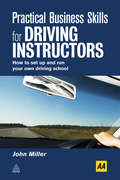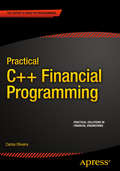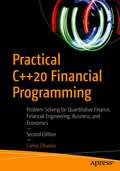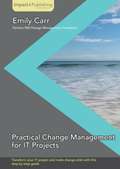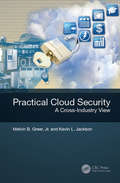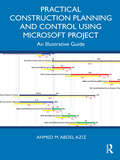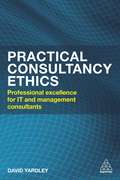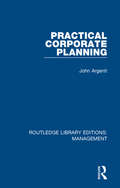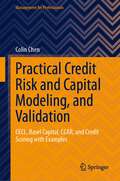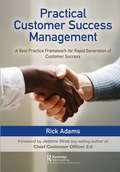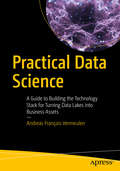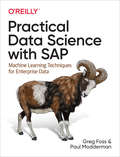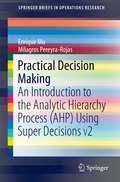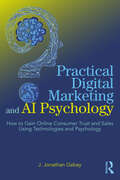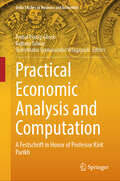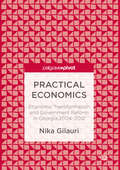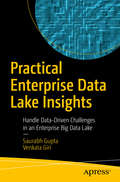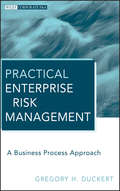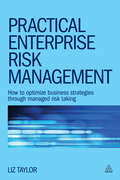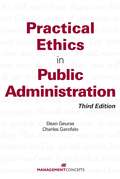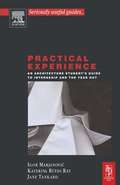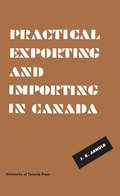- Table View
- List View
Practical Business Skills for Driving Instructors
by John MillerOver 20,000 people apply to become an Approved Driving Instructor each year, but whether you are a sole trader or franchisee, you will need more than just the instructional skills that are tested in the official DSA qualifying exams. Practical Business Skills for Driving Instructors, by the author of the definitive Driving Instructor's Handbook, provides solid, practical advice to help you set up your own business. Each business topic is dealt with in the author's down-to-earth style including: preparing a business plan, financing the business, choosing and maintaining a car, book-keeping, sales and marketing, and presenting a professional image. Whether you are just considering becoming a driving instructor, or have just passed your ADI exams, Practical Business Skills for Driving Instructors will help you ensure your new career is a huge success.
Practical C++ Financial Programming
by Carlos OliveiraPractical C++ Financial Programming is a hands-on book for programmers wanting to apply C++ to programming problems in the financial industry. The book explains those aspects of the language that are more frequently used in writing financial software, including the STL, templates, and various numerical libraries. The book also describes many of the important problems in financial engineering that are part of the day-to-day work of financial programmers in large investment banks and hedge funds. The author has extensive experience in the New York City financial industry that is now distilled into this handy guide. Focus is on providing working solutions for common programming problems. Examples are plentiful and provide value in the form of ready-to-use solutions that you can immediately apply in your day-to-day work. You'll learn to design efficient, numerical classes for use in finance, as well as to use those classes provided by Boost and other libraries. You'll see examples of matrix manipulations, curve fitting, histogram generation, numerical integration, and differential equation analysis, and you'll learn how all these techniques can be applied to some of the most common areas of financial software development. These areas include performance price forecasting, optimizing investment portfolios, and more. The book style is quick and to-the-point, delivering a refreshing view of what one needs to master in order to thrive as a C++ programmer in the financial industry. Covers aspects of C++ especially relevant to financial programming. Provides working solutions to commonly-encountered problems in finance. Delivers in a refreshing and easy style with a strong focus on the practical. What you'll learn Understand the fundamental problem types in the financial market. Design algorithms to solve financial programming problems. Extend C++ through Python extensions and LUA modules. Employ third-party numeric libraries such as those from Boost. Properly engage key C++ features such as templates and exception handling. Benefit from new features in C++14, such as auto variables and closures. Who this book is for Practical C++ Financial Programming is for professionals or advanced students who have interest in learning C++ financial programming, especially in preparation for a professional career. Readers should have a working-knowledge of programming in C, C++, or some other C-like language. The book is also useful to current practitioners at financial institutions as a ready-reference to common development problems and techniques. Table of Contents The Fixed-Income Market The Equities Market C++ Programming Techniques in Finance Common Libraries for Financial Code Designing Numerical Classes Plotting Financial Data Linear Algebra Interpolation Calculating Roots of Equations Numerical Integration Solving Partial Differential Equations Algorithm Optimization Portfolio Optimization Monte Carlo Methods for Equity markets Extending Financial Libraries C++ with R and Octave Multithreading Appendix A: C++14 Features
Practical C++20 Financial Programming: Problem Solving for Quantitative Finance, Financial Engineering, Business, and Economics
by Carlos OliveiraApply C++ to programming problems in the financial industry using this hands-on book, updated for C++20. It explains those aspects of the language that are more frequently used in writing financial software, including the Standard Template Library (STL), templates, and various numerical libraries. Practical C++20 Financial Programming also describes many of the important problems in financial engineering that are part of the day-to-day work of financial programmers in large investment banks and hedge funds. The author has extensive experience in the New York City financial industry that is now distilled into this handy guide. Focus is on providing working solutions for common programming problems. Examples are plentiful and provide value in the form of ready-to-use solutions that you can immediately apply in your day-to-day work. You’ll see examples of matrix manipulations, curve fitting, histogram generation, numerical integration, and differential equation analysis, and you’ll learn how all these techniques can be applied to some of the most common areas of financial software development. These areas include performance price forecasting, optimizing investment portfolios, and more. The book style is quick and to-the-point, delivering a refreshing view of what one needs to master in order to thrive as a C++ programmer in the financial industry. What You Will Learn Cover aspects of C++ especially relevant to financial programming Write working solutions to commonly encountered problems in finance Design efficient, numerical classes for use in finance, as well as to use those classes provided by Boost and other libraries Who This Book Is For Those who are new to programming for financial applications using C++, but should have some previous experience with C++.
Practical Change Management for IT Projects
by Emily CarrTransform your IT project and make change stick with this step-by-step guide. In today's fast-paced world of change, companies expect you to do more, with less. Drawing on over a decade of Change Management experience as a consultant with Fortune 500 companies including IBM and NCR, Emily Carr shares the secrets to making change happen smoothly. If your company is like most, the number one reason that projects have failed over the years don't have to do with technology. They have to do with people. People didn't like the new technology. People weren't trained properly on the change. People hadn't received adequate communications and didn't understand the change. Sound familiar? Project teams rarely forget to work on the technology, but they often forget to work with the people, and no matter how amazing your new technology is, it's useless unless people use it efficiently. This book will help you focus on the people. Packed with templates, checklists, and real-life examples, this user-friendly guide will provide you with the insights and guidance of an expert consultant, for a fraction of the price. You'll follow a clearly laid out path from Change Management novice to confident and prepared change manager. You'll be introduced to the Five Pillars of Change: Sponsorship, Stakeholder Management, Communication, Training, and Organization Design. You will work step-by-step through templates in each pillar to build and run a comprehensive Change Management plan tailor-made to your project and organization. About the Author: Emily Carr has been working as a Change Management consultant for over a decade. As a consultant, she has worked with Fortune 500 companies to develop and execute successful Change Management, communications, and training programs for large-scale business and IT projects. These programs have had global reach across the United States, Australia, India, Eastern Europe, and the Middle East. Emily is also the author of the popular Change Management blog, Practical Change Management.
Practical Cloud Security: A Cross-Industry View
by Kevin L. Jackson Melvin B. Greer, Jr.Melvin Greer and Kevin Jackson have assembled a comprehensive guide to industry-specific cybersecurity threats and provide a detailed risk management framework required to mitigate business risk associated with the adoption of cloud computing. This book can serve multiple purposes, not the least of which is documenting the breadth and severity of the challenges that today’s enterprises face, and the breadth of programmatic elements required to address these challenges. This has become a boardroom issue: Executives must not only exploit the potential of information technologies, but manage their potential risks. Key Features • Provides a cross-industry view of contemporary cloud computing security challenges, solutions, and lessons learned • Offers clear guidance for the development and execution of industry-specific cloud computing business and cybersecurity strategies • Provides insight into the interaction and cross-dependencies between industry business models and industry-specific cloud computing security requirements
Practical Construction Management
by R. H. Ranns E. J. RannsFilled with practical advice for all aspects of the construction manager's role, this invaluable book fills a need for training in this essential subject, to ensure greater efficiency on site and smoother client-contractor relations. Developed as a handy-reference guide for practitioners and also useful for students, it covers the broad range of responsibilities associated with the role, providing clear guidance and in-depth coverage of the essentials. Topics include financial responsibilities and how to handle them, tender preparation, people management, health and safety, contracts, subcontracting, measurement and quantities, insurance and risk and many more simple and effective methods for turning construction projects into reality.
Practical Construction Planning and Control Using Microsoft Project: An Illustrative Guide
by Ahmed M. AzizPractical Construction Planning and Control Using Microsoft Project serves as a practical guide, explaining how to implement the Critical Path Method (CPM) in construction projects using Microsoft Project, filling a clear gap in the academic literature. For working professionals, it provides an all-in-one guide to construction project management using Microsoft Project, which can be used for self-learning or training purposes. The book provides project managers with definitive reports covering every aspect of project management, including time, cost, resources, work, and cash flow, as well as custom-built dashboard reports for effective project management.This textbook provides a brief description of the CPM phases of planning, scheduling, and control. Using a consistent example project throughout every chapter of the book, each CPM phase is explained using the relevant Microsoft Project commands and functionalities, accompanied by explanations and illustrations that describe the implementation. Furthermore, the chapters offer detailed descriptions and steps for generating common construction scheduling deliverables, including network diagrams, Gantt chart schedules, and cash flow reports.Following an Introduction that lays out the essential concepts, the 13 chapters provide an implementation of Microsoft Project for planning, scheduling, resources, monitoring and control, time and cost updates, progress measurement using earned value analysis, and project reporting. By successfully combining the details of CPM as a management technique with illustrated guidance on Microsoft Project, the book presents an ideal teaching tool for use in construction management, construction engineering, and project management degree programs, as well as for professionals eager to learn construction project scheduling using the widely available Microsoft Project software.
Practical Consultancy Ethics: Professional Excellence for IT and Management Consultants
by David YardleyConsultants - working for an organization but not as part of it - are particularly subject to commercial pressures from both their employers and their clients, never more so than when consulting on complex and costly IT engagements. A consultant's reputation is crucial to their professional capital, and they have to be able to make defensible decisions that protect this reputation whilst delivering value for the client. This means acting ethically, responsibly and commercially. Practical Consultancy Ethics approaches the subject of ethics from the individual's perspective: the management or IT consultant who will need to make ethical decisions within their engagement. With clear-sighted identification of the ethical dilemmas that may arise at each stage of a consultancy project - from defining the problem to fit the solution, through to prioritizing competing stakeholder needs, and having access to confidential client information - and guidance on ethical and risk-reducing actions that consultants can take, the emphasis throughout is on improved decision-making. Enhanced with case studies showcasing real-life ethical pitfalls and featuring consultancy ethical dilemmas to challenge the reader, this is a uniquely practical guide to applying best ethical practice in consulting engagements.
Practical Corporate Planning: A Practical Guide (Routledge Library Editions: Management #4)
by John ArgentiIn this book, originally published in 1980, John Argenti deliberately and systematically strips away the sophisticated methods for corporate planning to get down to a practical corporate planning process that works. This accessible book uses no jargon or maths, and will be of interest to students of management and business studies. It is also aimed at chief executives, managing directors and other very senior executives in companies and non-profit-making organisations.
Practical Credit Risk and Capital Modeling, and Validation: CECL, Basel Capital, CCAR, and Credit Scoring with Examples (Management for Professionals)
by Colin ChenThis book provides professionals and practitioners with a comprehensive guide on credit risk modeling, capital modeling, and validation for Current Expected Credit Loss (CECL), International Financial Reporting Standard 9 (IFRS9), Basel Capital and Comprehensive Capital Analysis and Review (CCAR) procedures. It describes how credit risk modeling, capital modeling, and validation are done in big banks with code and examples. The book features innovative concepts such as Binary Logit Approximation (BLA) for Competing Risk Framework; Adaptive and Exhaustive Variable Selection (AEVS) for automatic modeling; Full Observation Stratified Sampling (FOSS) for unbiased sampling; and Prohibited Correlation Index (PCI) for Fair Lending Texts. It also features a chapter on credit underwriting and scoring, addressing the credit underwriting risk with some innovations. It is a valuable guide for professionals, practitioners and graduate students in risk management.
Practical Customer Success Management: A Best Practice Framework for Rapid Generation of Customer Success
by Rick Adams"This book contains so much common sense that my neck was getting tired from nodding my head in agreement so often." Peter Armaly, Senior Director Customer Success, Oracle "…a comprehensive review of the Customer Success role and responsibilities…" Anne Marie Ponder, Senior Manager, IT Infrastructure, Astellas Pharma US "…a must read playbook for all business leaders and customer success-focused professionals." Jason Noble, Global Customer Success and SaaS Leader "I wish a book like this existed when I started in Customer Success!" Cyn Taylor, Enterprise Customer Success Manager, LogicMonitor "…provides all the ingredients to create the right customer success strategy." Baptiste Debever, Head of Growth & Co Founder, Alkalab "…an invaluable resource for anyone with an interest in Customer Success." Adam Joseph, CEO, CSM insight "A structured and logical approach that will help new and experienced CSMs to bridge the gap between Customer Success theory and practical application." James Scott, General Partner, Success Hacker Customer success management is "the practice of helping customers to generate value from using our products" and it is a relatively new and fast-growing profession with many new CSMs coming into it from other customer-facing professions. Due to the speed with which the profession is undergoing change as it matures and expands, both new and existing CSMs need to keep abreast of customer success best practice. However there are relatively few books that provide much in the way of practical guidance for customer success practitioners and even less options for resources such as tools, templates and checklists that enable a consistently high quality approach whilst increasing the CSM’s productivity. Practical Customer Success Management is a practical guide book and comprehensive training manual for CSMs that provides a simple to follow, best practice framework that lays out the core steps at every stage of the customer journey to business outcome success. It describes and explains which situations each step applies to and provides recommendations for activities or tasks that the CSM can perform to complete each step, together with detailed guidance for successfully completing those activities. The book also includes a suite of tools and templates that enable rapid completion of tasks whilst ensuring consistency of approach both across multiple customer engagements and by multiple CSMs within a team.
Practical Data Science
by Andreas François VermeulenLearn how to build a data science technology stack and perform good data science with repeatable methods. You will learn how to turn data lakes into business assets.The data science technology stack demonstrated in Practical Data Science is built from components in general use in the industry. Data scientist Andreas Vermeulen demonstrates in detail how to build and provision a technology stack to yield repeatable results. He shows you how to apply practical methods to extract actionable business knowledge from data lakes consisting of data from a polyglot of data types and dimensions.What You'll LearnBecome fluent in the essential concepts and terminology of data science and data engineering Build and use a technology stack that meets industry criteriaMaster the methods for retrieving actionable business knowledgeCoordinate the handling of polyglot data types in a data lake for repeatable resultsWho This Book Is ForData scientists and data engineers who are required to convert data from a data lake into actionable knowledge for their business, and students who aspire to be data scientists and data engineers
Practical Data Science with SAP: Machine Learning Techniques for Enterprise Data
by Greg Foss Paul ModdermanLearn how to fuse today's data science tools and techniques with your SAP enterprise resource planning (ERP) system. With this practical guide, SAP veterans Greg Foss and Paul Modderman demonstrate how to use several data analysis tools to solve interesting problems with your SAP data.Data engineers and scientists will explore ways to add SAP data to their analysis processes, while SAP business analysts will learn practical methods for answering questions about the business. By focusing on grounded explanations of both SAP processes and data science tools, this book gives data scientists and business analysts powerful methods for discovering deep data truths.You'll explore:Examples of how data analysis can help you solve several SAP challengesNatural language processing for unlocking the secrets in textData science techniques for data clustering and segmentationMethods for detecting anomalies in your SAP dataData visualization techniques for making your data come to life
Practical Decision Making
by Enrique Mu Milagros Pereyra-RojasThis book offers a simple introduction to the fundamentals and applications of the Analytic Hierarchy Process (AHP) without a pre-requisite for a sophisticated mathematical background. It provides a quick and intuitive understanding of the methodology using spreadsheet examples and explains in a step-by-step fashion how to use Super Decisions, a freely available software developed by the Creative Decisions Foundations. The book is intended to be a resource for decision makers with little or no exposure to the field of Operations Research (OR); however, the book can be used as a very gentle introduction to the AHP methodology and/or as an AHP hands-on supplement for standard OR textbooks. AHP is an intuitive and mathematically simple methodology in the field of multi-criteria decision making. Because of this, most AHP books assume the reader has basic OR mathematical background. However, AHP simplicity suggests that decision makers from all disciplines can take advantage of the methodology without struggling with the mathematics behind it. To fulfill this need, this book delivers a quick and practical understanding of the method that can be useful for corporate executives.
Practical Digital Marketing and AI Psychology: How to Gain Online Consumer Trust and Sales Using Technologies and Psychology
by J. Jonathan GabayPractical Digital Marketing and AI Psychology explores how successful brands utilise both psychology and cutting-edge artificial intelligence technologies to maximise digital marketing strategies.Psychology has long been a foundation for successful marketing strategies, and evolving AI technologies are opening up new opportunities for marketers to help brands build trust and loyalty online. In this exceptional book, award-winning writer Jonathan Gabay delves into fascinating psychological digital marketing techniques and concepts, explaining the practical psychology and science you need to lift your marketing career to the next level. Gabay explores how new technologies can be harnessed to increase their impact significantly. The book provides practical tips and contemporary best-practice examples, including prompt engineering, the psychology behind mission statements and logo design, gamification, the possibilities and pitfalls of social media, among many more areas that will ensure your brand is trusted, valued, and desired.This definitive book is perfect for marketing students up to PhD level and digital marketing, PR, and sales professionals looking for a fascinating, compelling read, packed with ideas and examples, that combines academic excellence with practical advice – all written and presented in a highly accessible style.
Practical Economic Analysis and Computation: A Festschrift in Honor of Professor Kirit Parikh (India Studies in Business and Economics)
by Probal Pratap Ghosh Rajbans Talwar Sureshbabu Syamasundar VelagapudiThis book pays tribute to Professor Kirit Parikh through contemporary essays from experts on energy, climate change including mitigation and adaptation, agriculture, food procurement, water resources, and public health. The chapters use statistical methods and mathematical models to analyse questions of policy formulation and effectiveness. The book picks up important SDG topics such as – current issues and policy making in the infrastructure sector of power and their relationship to India’s climate commitments; computable models of the growth and absorption of renewable generation as the focal point of policy interventions in the power sector; increasing efficiency of national grids and to support integration of renewables in South Asia; natural gas pricing policy; achieving, nutrition, self-sufficiency and foodgrains surplus; welfare implications of the minimum support price (MSP) policy for food grains; evaluating epidemiological performance of strategies against COVID-19; critical examination of economic growth; methodological issues in policy formulation; modeling the Social Accounting Matrix; algorithms for solving convex optimization models; and fossil fuel power plant operations. The studies especially bring into focus the latest developments in climate change, the switch to renewable energy sources, and the public health crisis due to COVID-19. This collection will be of great value to policymakers and researchers, especially from a developing economy perspective.
Practical Economics
by Nika GilauriThis book is open access under a CC BY license. In this book, Nika Gilauri reveals his formulas for government reform and economic recovery, including how to fight against corruption, reform fiscal policy and tax systems, privatize state-owned enterprises, build a welfare system for those most in need, create a competitive education and healthcare system, and streamline procurement. All formulas are corroborated by practical experience and empirical evidence gathered during Mr Gilauri's term as a cabinet member (2004-2009) and prime minister (2009-2012) of Georgia, and provide an in-depth view of what worked in the case of Georgia since 2003, and how lessons learned could be applied in other parts of the world.
Practical Enterprise Data Lake Insights: Handle Data-Driven Challenges in an Enterprise Big Data Lake
by Saurabh Gupta Venkata GiriUse this practical guide to successfully handle the challenges encountered when designing an enterprise data lake and learn industry best practices to resolve issues.When designing an enterprise data lake you often hit a roadblock when you must leave the comfort of the relational world and learn the nuances of handling non-relational data. Starting from sourcing data into the Hadoop ecosystem, you will go through stages that can bring up tough questions such as data processing, data querying, and security. Concepts such as change data capture and data streaming are covered. The book takes an end-to-end solution approach in a data lake environment that includes data security, high availability, data processing, data streaming, and more.Each chapter includes application of a concept, code snippets, and use case demonstrations to provide you with a practical approach. You will learn the concept, scope, application, and starting point.What You'll LearnGet to know data lake architecture and design principlesImplement data capture and streaming strategiesImplement data processing strategies in HadoopUnderstand the data lake security framework and availability modelWho This Book Is ForBig data architects and solution architects
Practical Enterprise Risk Management
by Gregory H. DuckertThe most practical and sensible way to implement ERM-while avoiding all of the classic mistakesEmphasizing an enterprise risk management approach that utilizes actual business data to estimate the probability and impact of key risks in an organization, Practical Enterprise Risk Management: A Business Process Approach boils this topic down to make it accessible to both line managers and high level executives alike. The key lessons involve basing risk estimates and prevention techniques on known quantities rather than subjective estimates, which many popular ERM methodologies consist of.Shows readers how to look at real results and actual business processes to get to the root cause of key risksExplains how to manage risks based on an understanding of the problem rather than best guess estimatesEmphasizes a focus on potential outcomes from existing processes, as well as a look at actual outcomes over timeThroughout, practical examples are included from various healthcare, manufacturing, and retail industries that demonstrate key concepts, implementation guidance to get started, as well as tables of risk indicators and metrics, physical structure diagrams, and graphs.
Practical Enterprise Risk Management
by Liz TaylorPractical Enterprise Risk Management addresses the real need for organizations to take more managed risks in order to maximise business strategies and achieve long term goals. Based on ISO 31000 and applying current best practice, it provides templates and examples that can be adapted for any industry. Breaking down the theory on enterprise risk management, it helps you see risk as both an opportunity and a threat whilst giving you guidance on how to implement it. It provides models for Risk Adjusted Return on Capital to evaluate R.O.I and measure performance, advice on emergent risks, as well as best practice and advice on risk communication, transparency and protecting the brand.Including a comprehensive overview of risk management responsibilities for boards, Practical Enterprise Risk Management lifts the lid on the whole process, helping you to embed ERM into your organization, reach your goals and take more managed risks.
Practical Enterprise Risk Management: How to Optimize Business Strategies Through Managed Risk Taking
by Liz TaylorPractical Enterprise Risk Management addresses the real need for organizations to take more managed risks in order to maximize business strategies and achieve long term goals. Based on ISO 31000 and applying current best practice, it provides templates and examples that can be adapted for any industry. Breaking down the theory on enterprise risk management, it helps you see risk as both an opportunity and a threat whilst giving you guidance on how to implement it. It provides models for Risk Adjusted Return on Capital to evaluate R.O.I and measure performance, advice on emergent risks, as well as best practice and advice on risk communication, transparency and protecting the brand.Including a comprehensive overview of risk management responsibilities for boards, Practical Enterprise Risk Management lifts the lid on the whole process, helping you to embed ERM into your organization, reach your goals and take more, and more effective, managed risks.
Practical Ethics In Public Administration
by Dean Gueras Charles GarofaloMake the Right Choice - Enhance Your Ethical Decision Making Skills Today!Ethical issues arise in all walks of life, but none have implications as far-reaching and serious as those related to public management. Most people working in the public sector want to do the "right" thing, but the issues can be highly complex or just not lend themselves to easy answers. Practical Ethics in Public Administration, Third Edition, provides the tools, techniques, and methods needed to help meet these challenges. This completely updated third edition provides public sector professionals the information they need to face the ethical issues that arise in the course of a day's work, address those issues with greater self-assurance, perform their duties in an ethically justifiable manner, and explain their actions reasonably.This new edition:• Covers emerging ethical issues surrounding public-private partnerships• Examines the shift from compliance-based to integrity-based ethics programs• Explores the context of moral competency
Practical Ethics in Architecture and Interior Design Practice
by David Wang Dana E. Vaux Sue Lani MadsenPractical Ethics in Architecture and Interior Design Practice presents the basics of design practice through ethical scenarios, ushering design students into real-world experiential learning. Each chapter begins with a detailed story involving a complicated set of practical and ethical dilemmas, exemplifying those encountered each day in the world of professional practice. Practice-based topics such as contracts and project delivery methods, marketing design services, cross-cultural collaboration, virtual connectivity, social justice and sustainable design, soft skills, and other related professional practice themes are anchored in realistic scenarios. While all the stories are fictional, in writing them the authors drew from over seventy-five combined years of professional experience in architecture and interior design as well as many years of academic experience in teaching professional practice and ethics to architecture and interior design students. Each story is followed by discussion questions and suggested additional resources. This book provides a unique integrated perspective into the allied fields of architecture and interior design with topics relevant to both fields as well as specific to each profession. It prepares students of both disciplines for the broad issues of professional practice and encourages them to become ethical practitioners ready to contribute effectively to design teams and to ask the right questions.
Practical Experience: An Architecture Student's Guide To Internship And The Year Out
by Katerina Ruedi Ray Jane TankardThe year out, or internship, in a professional practice can be the most rewarding experience in an architectural student's education. It can also be a shock to the system to find that architectural working practices are very different to architectural study. This book provides a beginner's guide to professional practice and a step-by-step guide on how to find the placement that best suits your goals. It is the fourth title in the successful 'Seriously Useful Guides...' series.In order to give you a real insight into professional experience, this guide includes reallife case studies from students who have been through the experience and from practices that have taken them on. It guides you through the steps of finding a placement, outlines the norms and expectations for internship in different countries, and discusses codes of office behavior and professional ethics. Contemporary architecturalpractices are becoming increasingly diverse and this guide outlines some Practical experience/Internship choices, providing cases studies of award wining firms that offer practical experience. These case studies range from conventional practices based on the art of building, to practices based on digital media or contemporary urbanism. Finally, the term 'critical practice' is becoming increasingly important, and the book provides some definitions and examples of critically based architectural practices.Also in the Seriously Useful Guides Series:* The Crit* The The Portfolio* The Dissertation
Practical Exporting and Importing in Canada
by J. R. ArnoldAs every schoolboy knows, Canada is one of the larger trading countries of the world but, from the point of view of balancing her international merchandise trade payments, she does not export enough. The purpose of this book is to describe, not in broad economic terms, but in daily practical detail, the work of the exporter and importer. Pitfalls abound for the unwary trader, and Mr. Arnold knows them all. His book is written about the activities of an export merchant, since he, unlike his confrères in a larger type of organization, deals directly himself with banks, brokers, suppliers, shippers, buyers, insurance agents, freight forwarders, and the other agencies serving the exporter and importer. Thus the reader acquires an all-round understanding of the trader's business world. The book is written with admirable directness and clarity, with an astute and alert business sense underlying the writing. The book will also make useful reading for any student of international trade theory and would be especially helpful to commerce classes and to trainees in business firms of all kinds associated with Canadian trade.
